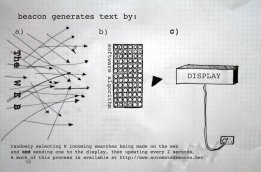Sculpting the Web
This investigation aimed to contribute to our understanding of how global communications systems like the worldwide web are transforming the way we perceive the world around us.
Featured Media

BFI, London

BFI, London

For Beacon installation

BFI, London

BFI, London

For Beacon installation
This investigation aimed to contribute to our understanding of how global communications systems like the worldwide web are transforming the way we perceive the world around us. It also sought to push the boundaries of what constitutes an art object, while exploring how to make broad meaningful representations of something as large and fluid as the internet, to a collective audience in a public space rather than to individuals using a computer. In doing so it aimed to reveal something poetic about humanity's collective similarities and differences.
This investigation's objectives were to:
- research existing examples in contemporary art of where connections have been made between the virtual space of the web and physical spaces and to examine examples of digital information being conveyed by analogue and mechanical means
- develop software able to sample live search engine data, particularly the searches people are making around the world at any given moment
- build and test a mechanical means by which such virtual data grabbed from the web can be conveyed in a public space like the busy foyer of an art museum or a gallery space
- convey live virtual data in a way that does not require special lighting conditions and that can exist as a monumental semi-permanent artwork
- establish a way in which the long term evaluation of the work and the audience's relationship with it could take place
- document the resulting artwork online and through publishing a downloadable catalogue about the research
- present the research in artist talks and public lectures.
For this proposal Jon Thomson researched, developed, built and tested a mechanical means by which a random selection of web searches being made by people around the world could be intercepted then broadcast live as an endless 'poetry' for a viewing public. It was realised in collaboration with Eddie Berg, Artistic Director at The British Film Institute (BFI Southbank).
I looked particularly at flap sign technology, which was commonly used in the twentieth century as a way of displaying travel information in stations and airports. My aim was to repurpose this kind of analogue technology to display the live virtual data, to offer up a persistent snapshot of humanity, and its needs and wants as played out at every moment on internet search engines.
The resulting monumental artwork is a silent witness but also something, which a passing audience can engage with in an immediate and meaningful way, either fleetingly or for longer periods. It was staged at the Foundation for Art and Creative Technology (FACT) in Liverpool and then at the BFI Southbank in London in 2007, both venues offering exciting contexts within which this semi-permanent artwork could be tested and evaluated. Artwork emerging from the research has also been shown at Friends of the Divded Mind, Royal College of Art, London and Timecode, Dundee Contemporary Arts in 2009.
For additional information, see www.thomson-craighead.net/docs/beacon.html